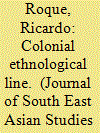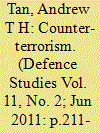| Srl | Item |
| 1 |
ID:
161452


|
|
|
|
|
| Summary/Abstract |
This article examines the connected histories of racial science and colonial geography in Island Southeast Asia. By focusing on the island of Timor, it explores colonial boundaries as modes of arranging racial classifications, and racial typologies as forms of articulating political geography. Portuguese physical anthropologist António Mendes Correia's work on the ethnology of East Timor is examined as expressive of these productive connections. Correia's classificatory work ingeniously blended political geography and racial taxonomy. Between 1916 and 1945, mainly based on data from the Portuguese enclave of Oecussi and Ambeno, he claimed a distinct Malayan racial type for the whole colony of ‘Portuguese Timor’. Over the years he developed an anthropogeographical theory that simultaneously aimed to reclassify East Timor and to revise the racial cartography of the Malay Archipelago, including Wallace's famous ethnological line.
|
|
|
|
|
|
|
|
|
|
|
|
|
|
|
|
| 2 |
ID:
106545


|
|
|
| 3 |
ID:
161455


|
|
|
|
|
| Summary/Abstract |
In the 1920s and 1930s, the Mestizos of Kisar, a dry, almost barren island in the Dutch East Indies off the coast of East Timor, were a model for the study of race mixing or human hybridity. Discovered in the late nineteenth century, these ‘anomalous blondes’ of Dutch and Kisarese ancestry became subjects of intense scrutiny by physical anthropologists. As a German specialist in tropical medicine in search of a convenient empire after 1918, Ernst Rodenwaldt favourably evaluated the physique and mentality of the isolated, fair Mestizos in the Dutch East Indies (now Indonesia). Back in Germany in the 1930s, as professor of hygiene at Heidelberg, his views on race hardened to accord with Nazi doctrine. Yet after the war, Rodenwaldt successfully cited his earlier appreciation of mixed-race peoples in the eastern Malay Archipelago as grounds for rehabilitation. Once a celebrated case study in human hybridity, the Mestizos of Kisar were erased from anthropological discussion in the 1950s, when race mixing ceased to be a biological issue and became instead a sociological interest. Still, Rodenwaldt's work continues to exert some limited influence in the eastern parts of the archipelago and among the Kisarese diaspora, indicating the penetrance and resilience of colonial racialisation projects.
|
|
|
|
|
|
|
|
|
|
|
|
|
|
|
|